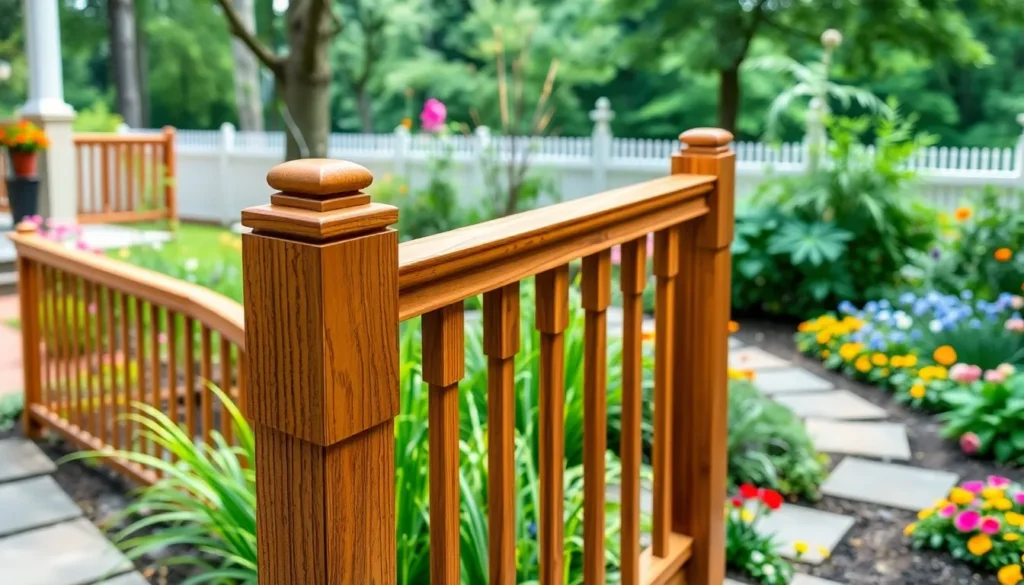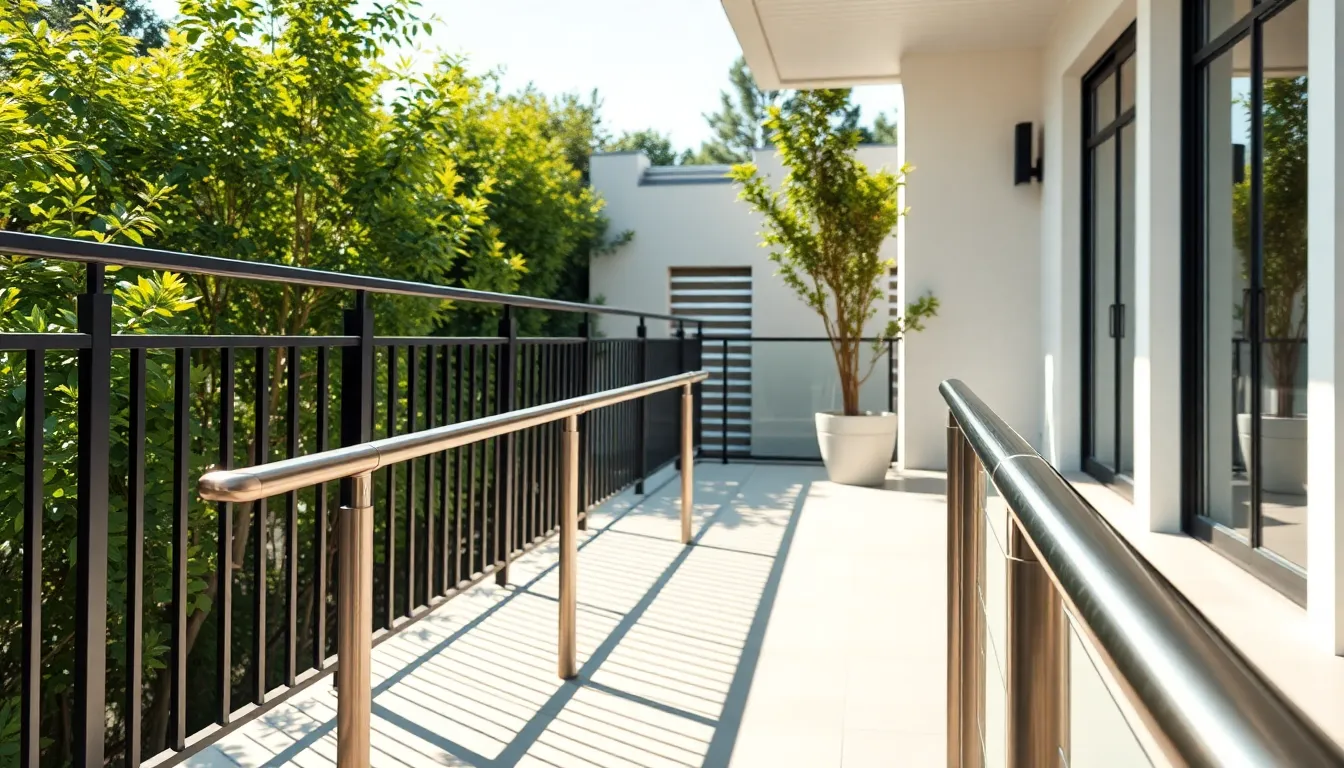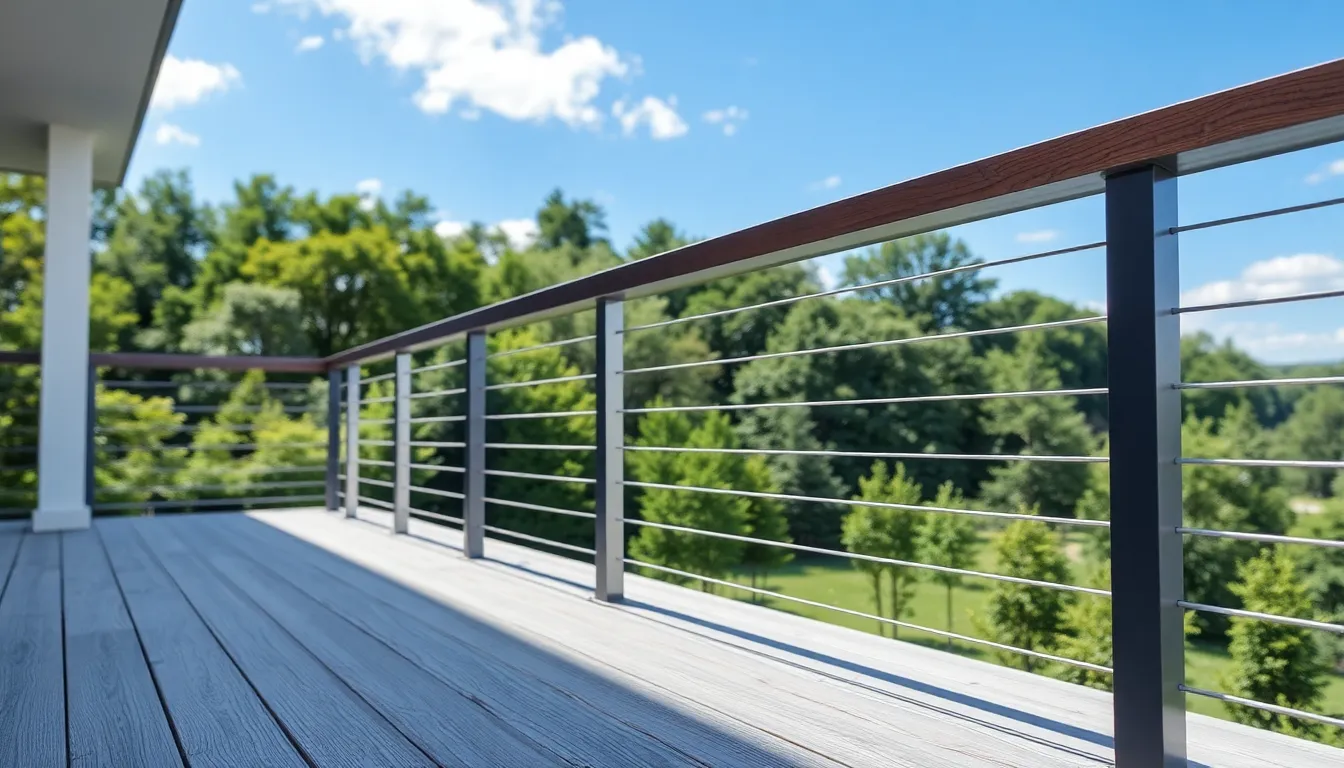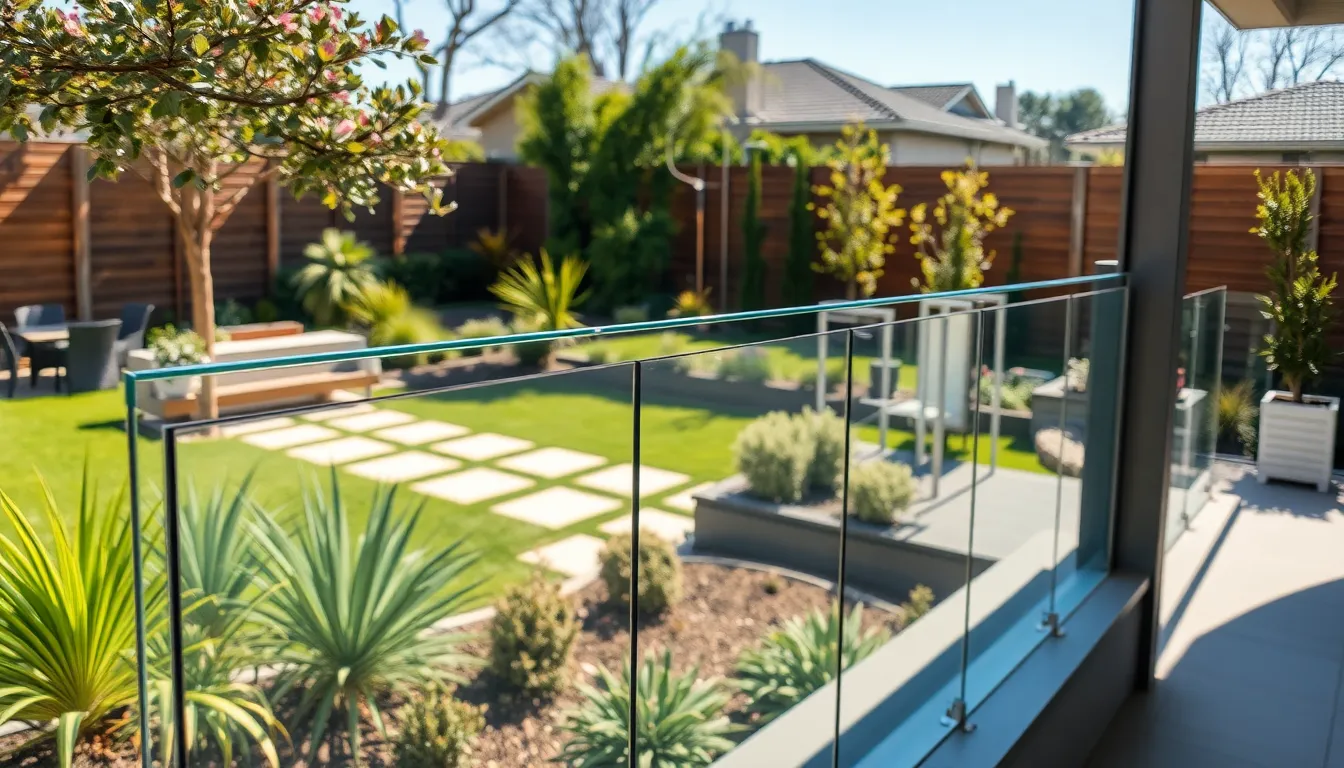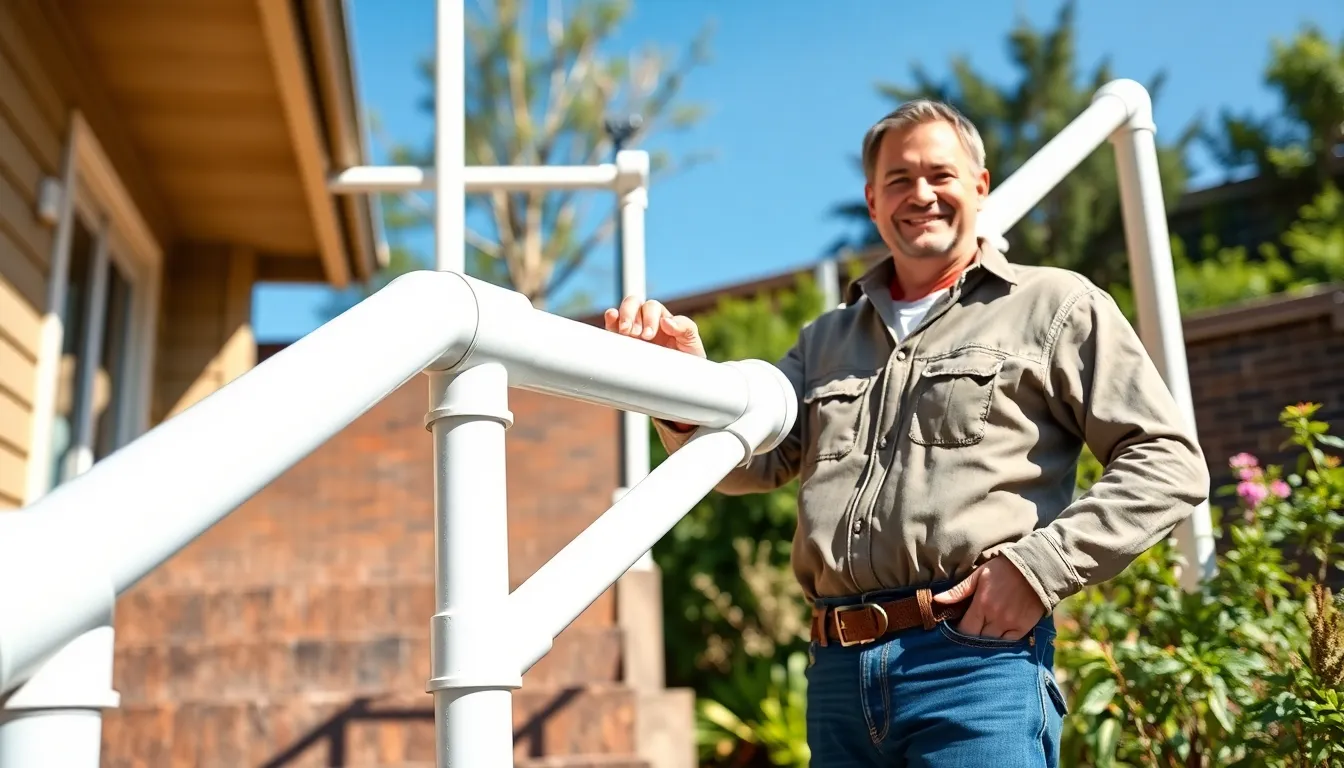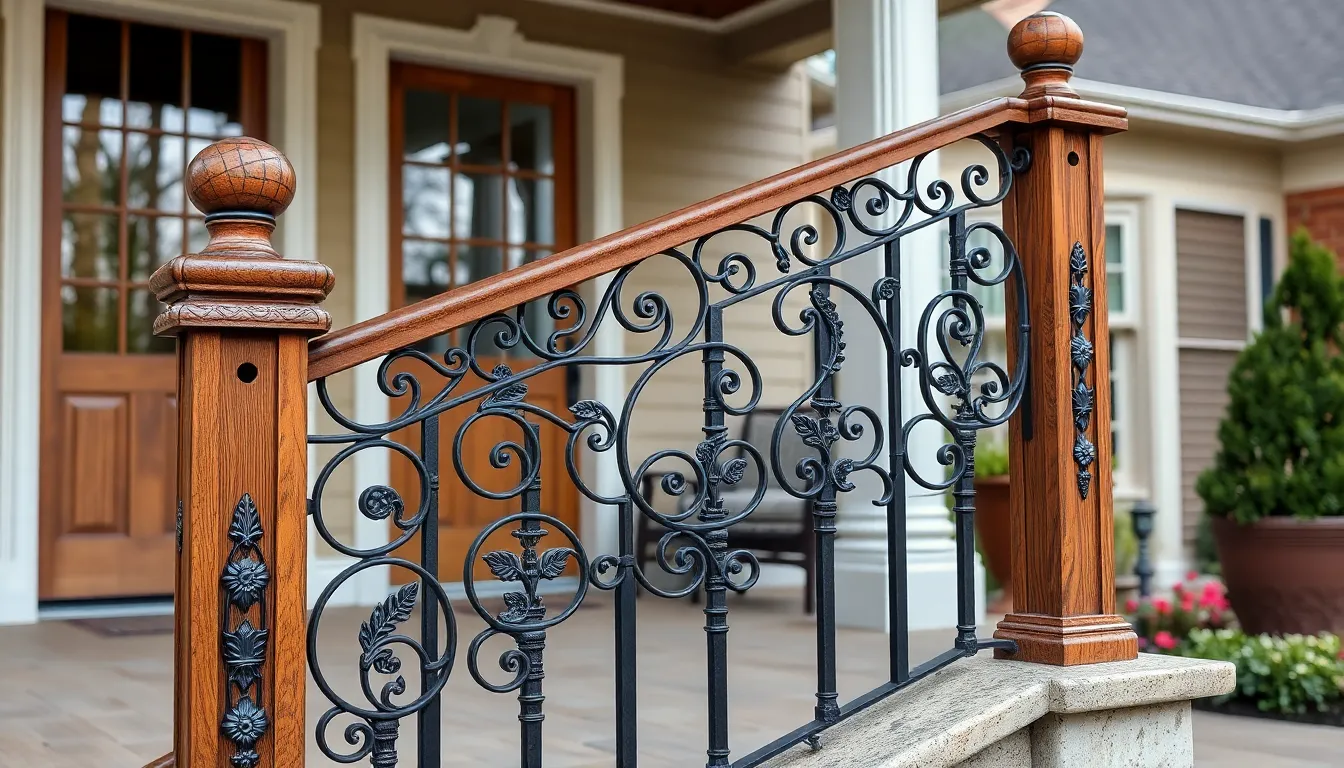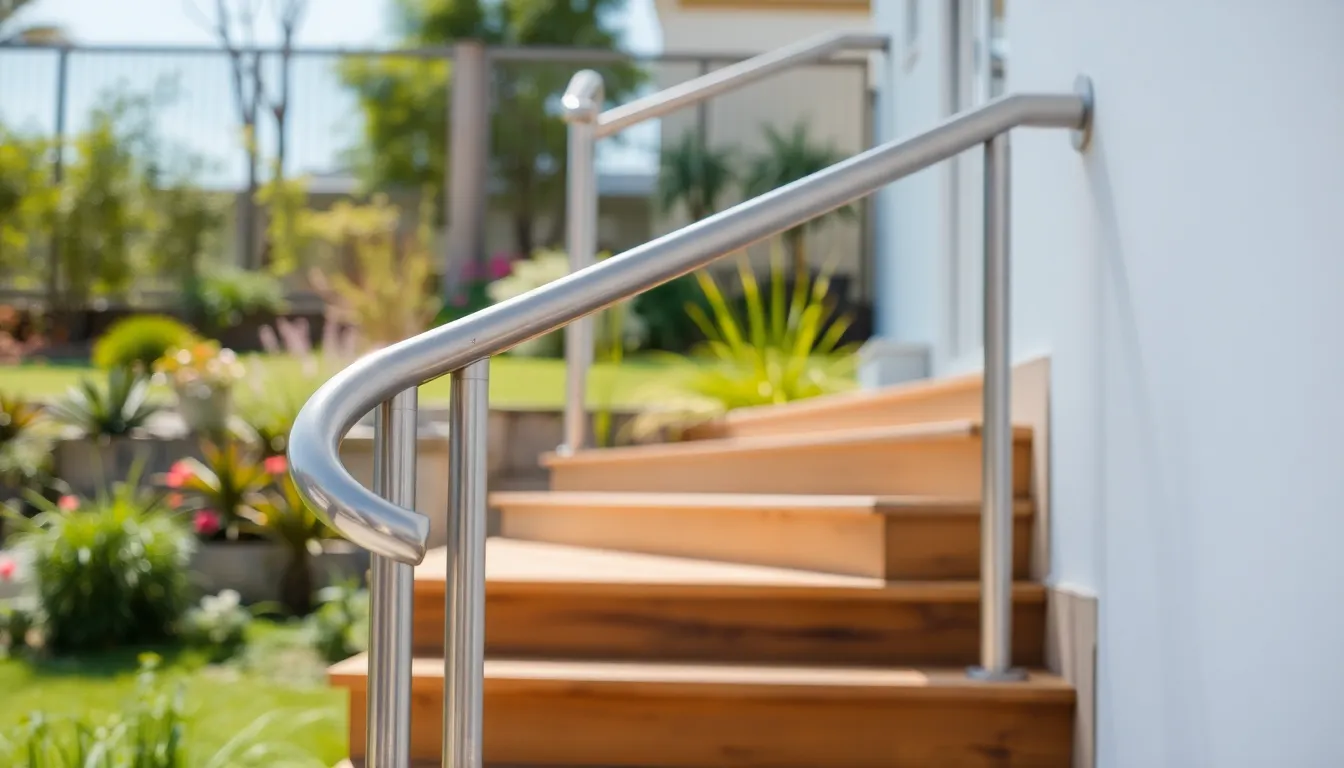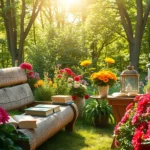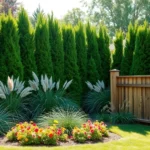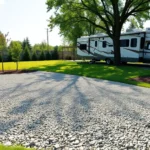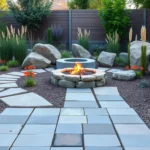We’ve all been there – standing on our outdoor steps or deck thinking about safety while wondering how to make our space look amazing. Outdoor handrails aren’t just about meeting building codes anymore; they’re about creating stunning focal points that blend functionality with incredible style.
Whether you’re dealing with steep garden steps, a sprawling deck, or a cozy front porch, the right handrail can transform your outdoor space from ordinary to extraordinary. We’re talking about options that’ll make your neighbors stop and stare – from sleek modern cable systems to rustic wooden designs that feel like they belong in a mountain retreat.
The best part? Today’s outdoor handrail ideas offer something for every budget, skill level, and design preference. We’ll show you how to choose materials that’ll withstand your local climate while creating the perfect balance between safety and curb appeal that’ll boost your home’s value.
Classic Wooden Hand Rail Ideas for Outdoor Spaces
Wood remains our top choice for outdoor handrails due to its timeless appeal and natural integration with industry settings. These classic wooden options offer durability and charm that complement any outdoor space.
Traditional Cedar Railing Systems
Cedar railing systems provide exceptional weather resistance and natural beauty for outdoor installations. We recommend cedar for its built-in insect repellent properties and resistance to rot, making it ideal for humid climates and coastal areas.
Standard cedar railing configurations include:
- Vertical spindle designs with 2×4 inch top rails
- Horizontal slat patterns spaced 4-6 inches apart
- Lattice panel inserts for enhanced privacy
- Curved corner sections for wraparound deck applications
Installation typically requires cedar posts spaced 6-8 feet apart, with galvanized hardware to prevent staining. Cedar weathers naturally to a silver-gray patina within 12-18 months, though many homeowners prefer applying clear sealers annually to maintain the original honey color.
Rustic Log Style Hand Rails
Log style hand rails create authentic outdoor charm using natural wood materials like pine, oak, or cedar logs. We often see these installations around cabin porches, mountain homes, and rustic deck areas where the organic shape enhances the natural setting.
Popular log railing features include:
- Peeled log posts ranging from 6-8 inches in diameter
- Branch or twig infill panels between main posts
- Mortise and tenon joinery for structural integrity
- Natural bark accents on select components
Construction involves selecting logs with minimal taper and proper moisture content below 19%. Each log requires hand-peeling and sanding to achieve smooth surfaces while preserving natural character marks and grain patterns.
Composite Wood Alternative Options
Composite wood handrails combine recycled wood fibers with plastic polymers to create low-maintenance outdoor railing answers. We appreciate these alternatives for their consistent appearance and resistance to splitting, warping, and insect damage.
Key composite handrail advantages:
| Feature | Benefit |
|---|---|
| Maintenance | No staining or sealing required |
| Durability | 25-30 year manufacturer warranties |
| Appearance | Consistent color and grain patterns |
| Installation | Pre-drilled components for easy assembly |
Popular composite brands like Trex, TimberTech, and Fiberon offer handrail systems in colors ranging from natural wood tones to contemporary grays and browns. These materials cost 20-40% more than traditional wood initially but eliminate ongoing maintenance expenses over time.
Modern Metal Hand Rail Designs for Contemporary Homes
Metal handrails offer durability and style that complement today’s architectural trends. We’ve identified three standout metal options that transform ordinary outdoor spaces into sophisticated design statements.
Sleek Stainless Steel Installations
Stainless steel handrails deliver the perfect balance of durability and modern aesthetics for contemporary outdoor spaces. We recommend these systems for homeowners seeking minimal maintenance requirements combined with weather resistance that lasts decades.
Key benefits include:
- Polished surfaces that reflect natural light and complement modern architecture
- Cable infill options that maintain unobstructed views while ensuring safety
- Glass panel compatibility for sophisticated, clean sight lines
- Corrosion resistance that eliminates rust concerns in humid climates
These installations work exceptionally well when paired with horizontal cable systems, creating an open feel that doesn’t compromise the visual connection between indoor and outdoor living areas.
Industrial Black Iron Railings
Black iron railings create bold visual statements that enhance contemporary homes with industrial design elements. We find these systems particularly effective for homeowners wanting dramatic contrast against natural backdrops and architectural features.
Design advantages:
- Strong visual impact that highlights key architectural elements
- Vertical baluster configurations that emphasize height and create elegant enclosure
- Powder coating options that prevent rust while maintaining the authentic iron appearance
- Versatile styling that complements both urban and rural contemporary settings
The bold contrast these railings provide makes them ideal for homes seeking to make a statement while maintaining the clean lines essential to modern design.
Aluminum Powder Coated Systems
Aluminum railings with powder coated finishes offer the most versatile solution for contemporary outdoor handrail applications. We’ve observed these systems gaining popularity due to their lightweight construction combined with exceptional strength and weather resistance.
System benefits:
| Feature | Advantage |
|---|---|
| Weight | 60% lighter than steel alternatives |
| Maintenance | Powder coating prevents rust and fading |
| Color Options | Custom tones available to match exterior palettes |
| Installation | Easier mounting compared to heavier metal systems |
White and black powder coated finishes remain the most popular choices, though custom colors allow for perfect coordination with existing exterior elements. These systems often replicate the appearance of steel while offering superior ease of installation and long term maintenance benefits.
Creative Cable Hand Rail Solutions for Unobstructed Views
Cable handrails offer the perfect balance between safety and scenic views, making them ideal for outdoor spaces where you don’t want to obstruct your surroundings. These systems maintain the required protection while keeping your deck, patio, or stairway feeling open and connected to nature.
Horizontal Cable Railing Systems
Horizontal cable railings feature tightly strung stainless steel cables running between posts to create clean, modern lines. We recommend these systems for decks and patios where surrounding scenery becomes the main attraction. The cables provide essential safety barriers without blocking your view of gardens, water features, or landscapes beyond.
Stainless steel cables offer exceptional durability and weather resistance for outdoor applications. Installation requires proper tensioning to meet safety codes while maintaining the sleek aesthetic. Posts need adequate spacing to ensure cables remain taut and secure over time.
Vertical Cable Design Options
Vertical cable railings create distinctive visual rhythm by running cables from top rail to bottom rail or base. We find these designs work particularly well with contemporary architectural styles that emphasize clean vertical lines. The upward orientation can make outdoor spaces appear taller and more dramatic.
Design flexibility allows for various spacing options between vertical cables. Some installations incorporate wider spacing for a more open feel, while others use closer spacing for enhanced safety around children or pets. The vertical pattern complements modern home designs and creates striking shadow patterns throughout the day.
Mixed Cable and Post Combinations
Mixed material combinations elevate cable railings from purely functional to statement design elements. We often combine stainless steel cables with wooden posts to soften the industrial appearance while maintaining contemporary appeal. Stone or metal posts paired with cables create different textural contrasts that complement various architectural styles.
Popular combinations include cedar posts with stainless cables for natural warmth, aluminum posts for lightweight durability, and steel posts for industrial strength. Post caps and hardware finishes can match or contrast with cable materials to create personalized design statements. These mixed approaches allow homeowners to balance modern cable aesthetics with materials that complement their home’s existing features.
Natural Stone and Masonry Hand Rail Concepts
Stone and masonry handrails bring enduring elegance to outdoor spaces while delivering the robust durability that harsh weather demands. These time-tested materials offer homeowners the perfect blend of natural beauty and structural integrity for their outdoor stairways and walkways.
Fieldstone Capped Railings
Fieldstone capped railings create a rustic, organic aesthetic that seamlessly blends with natural landscapes. These railings use irregularly shaped stones as the base structure, topped with flat stone slabs that provide a safe and comfortable handhold. We often see fieldstone bases constructed using either mortar or dry-stacked techniques, both producing that distinctive textured, earthy appearance.
The natural variation in stone shapes and colors makes each fieldstone railing unique, complementing garden pathways, patios, and front steps beautifully. Builders typically cap these railings with limestone, sandstone, or granite slabs that’ve been cut to provide smooth gripping surfaces. This construction method delivers exceptional stability while maintaining that coveted natural appearance that property owners love.
Brick and Mortar Traditional Styles
Brick and mortar handrails represent the epitome of classic design that never goes out of style. These handrails feature carefully stacked bricks held together with mortar in structurally sound configurations, often topped with smooth stone or concrete caps for enhanced comfort and durability. The brickwork can incorporate decorative patterns or contrasting mortar colors to add visual interest and architectural detail.
Traditional brick railings work exceptionally well with homes featuring brick facades or historical architectural themes. Craftsmen often create herringbone patterns, running bond layouts, or even decorative corbelling to match existing masonry work. The mortar joints can be tooled in various profiles, from concave to flush, allowing for customization that complements the overall design aesthetic.
Concrete Block Modern Designs
Concrete block handrails offer a contemporary approach with clean lines and geometric precision that appeals to modern homeowners. These blocks can be arranged in various configurations to create either open or solid railing designs, depending on privacy needs and aesthetic preferences. When paired with metal or wood caps, concrete blocks achieve that perfect balance between modern aesthetics and long-lasting durability.
Modern concrete block systems allow for innovative pattern creation and seamless integration with minimalist landscapes or contemporary architecture. We’ve seen designs incorporating decorative concrete blocks with geometric cutouts, creating interesting shadow patterns and visual texture. These systems often feature integrated lighting options or planters, transforming functional safety barriers into striking architectural elements that enhance the entire outdoor living space.
Glass Panel Hand Rail Ideas for Elegant Outdoor Areas
Glass panel handrails represent the pinnacle of modern outdoor design, offering unmatched transparency that showcases your industry while providing essential safety barriers.
Tempered Glass with Metal Frames
Tempered glass paired with metal frames creates a sophisticated outdoor handrail system that balances strength with visual appeal. We recommend stainless steel, aluminum, or powder-coated steel frames as they provide exceptional durability while supporting the glass panels securely. Metal frames resist weather conditions and maintain their structural integrity for years, making them ideal for decks, patios, and outdoor stairs.
The combination delivers clear sightlines through your outdoor space while the metal framework adds architectural interest. Stainless steel options offer the highest corrosion resistance, while aluminum frames provide lightweight installation benefits. Powder-coated steel frames come in various colors, allowing you to match your home’s exterior palette perfectly.
Safety features include tempered glass that’s up to five times stronger than regular glass, ensuring it meets building codes for outdoor applications. The glass panels typically measure 1/4 to 1/2 inch thick, providing the perfect balance between visibility and protection.
Frameless Glass Railing Systems
Frameless glass railings maximize your outdoor views by eliminating bulky frame elements that can obstruct sightlines. We install these systems using tempered glass panels that attach directly to posts or recess into deck surfaces through specialized clamps or channel brackets. This minimalist approach creates an uninterrupted visual flow that’s perfect for properties with scenic surroundings.
Installation methods include structural glazing systems that secure glass panels with minimal visible hardware. Post-mounted clamps provide another option, offering adjustability while maintaining the clean aesthetic. Channel systems recess the glass into grooves cut directly into deck surfaces, creating the most seamless appearance possible.
These systems work exceptionally well for balcony edges, waterfront decks, and elevated patios where preserving industry views takes priority. The lack of frames means easier cleaning and maintenance, as there are fewer surfaces where dirt and debris can accumulate.
Frosted Glass Privacy Options
Frosted glass panels provide privacy without sacrificing the modern elegance of glass handrail systems. We achieve this effect through sandblasting, acid etching, or applying specialty films that diffuse light while maintaining the glass’s structural properties. These panels work particularly well for backyard patios, hot tub areas, and outdoor stairs where neighbor privacy becomes a concern.
Etched designs can incorporate patterns, logos, or decorative elements that add visual interest beyond simple frosting. Custom etching allows you to match architectural details from your home or create unique artistic elements. The frosted surface softly diffuses natural light, creating ambient lighting effects during evening hours.
Privacy levels vary based on the frosting technique used, with heavier frosting providing complete opacity while lighter treatments maintain some transparency. We often combine frosted panels with clear sections to create ever-changing privacy answers that adapt to your exact needs and sightline requirements.
Budget-Friendly DIY Hand Rail Projects
Creating beautiful outdoor handrails doesn’t require very costly. We’ve found that most homeowners can complete professional-looking installations for under $100 using readily available materials and basic tools.
PVC Pipe Railing Answers
PVC pipe systems offer exceptional value for outdoor handrail projects due to their weather resistance and minimal maintenance requirements. We recommend using Kee Klamp fittings combined with PVC piping to create customizable answers that adapt to various outdoor configurations like porch landings or concrete stairs.
Installation becomes remarkably simple with slip-on fittings and open-end connections that require no specialized welding or cutting tools. The clean, modern appearance complements different exterior aesthetics while providing long-lasting durability against harsh weather conditions.
Weather resistance stands out as PVC’s greatest advantage, as these systems won’t rust, rot, or require annual painting like traditional materials. Most homeowners find that a complete PVC handrail system costs between $60 to $90 for standard staircase installations.
Repurposed Material Designs
Repurposed materials transform discarded items into functional safety features while reducing project costs significantly. We’ve seen creative homeowners use reclaimed wood from old fences, barns, or construction sites to create unique handrail designs that add character to outdoor spaces.
Metal pipes from plumbing renovations or industrial salvage yards provide excellent structural support when combined with wooden elements. Wire fencing remnants can serve as attractive infill panels between posts, creating an eco-friendly approach that costs 40-60% less than new materials.
Combining different repurposed elements allows for personalized designs that reflect individual style while maintaining safety standards. Old deck boards can become sturdy top rails, while salvaged balusters create authentic vintage charm at minimal expense.
Simple Wood and Wire Combinations
Wood post frameworks paired with wire cable infills deliver contemporary aesthetics without obstructing outdoor views. We recommend using pressure-treated 4×4 posts as anchor points, connected by galvanized steel cables that provide safety barriers while maintaining visual openness.
Tension cables stretched between wooden frames create clean horizontal lines that complement modern outdoor designs. This combination typically costs $40 to $70 for basic installations, making it one of the most affordable contemporary handrail answers.
Installation requires only basic carpentry skills and standard tools like a drill, level, and cable tensioning hardware. The wood provides structural integrity while wire elements ensure safety compliance, balancing functionality with visual appeal for decks and staircases.
Decorative Hand Rail Ideas with Architectural Details
Transform your outdoor handrails from purely functional barriers into stunning design focal points that complement your home’s architectural character. These decorative approaches combine safety with sophisticated styling elements that elevate your entire outdoor space.
Wrought Iron Ornamental Patterns
Scrollwork and leaf motifs create timeless elegance in wrought iron exterior railings that never go out of style. Custom ironworkers can create endless ornamental patterns including spirals, twists, botanical elements, and personalized shapes that reflect your unique aesthetic preferences. Powder coating options allow you to match these intricate railings to your existing exterior color scheme while providing long lasting durability against weather elements.
Traditional scrollwork patterns feature flowing curves and spirals that add movement and visual interest to straight stairways and porches. European inspired designs incorporate grape vines, roses, and acanthus leaves that create sophisticated focal points. Modern interpretations blend geometric elements with organic curves for contemporary homes seeking distinctive character.
Custom fabrication capabilities enable homeowners to incorporate family crests, monograms, or architectural motifs that match their home’s existing design language. Professional ironworkers can replicate historical patterns or create entirely new designs that complement your property’s unique features.
Carved Wooden Balusters
Hand carved spindles bring artisanal craftsmanship to outdoor handrail installations with traditional turning techniques and custom detailing options. Master woodworkers create classic spindle shapes, decorative urns, and intricate relief carvings that showcase exceptional skill and attention to detail. Cedar and mahogany provide excellent weather resistance while accepting stains and finishes beautifully.
Diamond and oval cutout lattices framed between sturdy posts offer both ornamental charm and functional safety barriers for deck and porch applications. These geometric patterns create interesting shadow play throughout the day while maintaining proper spacing requirements for building code compliance. Smooth handrail caps provide comfortable gripping surfaces above the decorative elements.
Colonial and Victorian reproductions feature historically accurate profiles and proportions that complement period architecture perfectly. Restoration specialists can match existing balusters or create new designs based on architectural drawings and historical references. Multiple wood species allow for color coordination with existing trim and siding materials.
Art Deco Inspired Geometric Designs
Stepped angular motifs capture the bold sophistication of Art Deco styling through repeating geometric arrangements in both wood and metal applications. Layered patterns featuring zigzag lines, stepped pyramids, and sunburst designs create dramatic visual impact on outdoor stairways and terraces. These designs work particularly well with contemporary and mid century modern architectural styles.
Grid and diamond arrangements echo the characteristic symmetry and mathematical precision that define Art Deco aesthetics perfectly. Wood slats arranged in diamond parquet patterns or metal bars configured in repeating grids provide safety while making bold design statements. Contrasting colors and finishes enhance the geometric impact of these architectural details.
Mixed material combinations allow you to incorporate both wood and metal elements in sophisticated Art Deco inspired compositions. Alternating materials create rhythm and visual interest while maintaining structural integrity and weather resistance. Powder coated metals paired with stained woods offer endless color combination possibilities for unique installations.
Safety-First Hand Rail Considerations for Outdoor Installation
Before diving into exact handrail designs, we must address the fundamental safety requirements that every outdoor installation demands. These considerations form the foundation of any successful handrail project.
Building Code Compliance Requirements
Building codes establish mandatory safety standards that we can’t overlook when installing outdoor handrails. Handrails must be installed on at least one side of all ramps with slopes steeper than 8.33% and on all stairways with four or more risers. The height requirements are equally critical, with handrails positioned between 34 inches and 38 inches measured vertically from the ramp slope or stair tread nosing.
Maximum projection from walls should not exceed 4.5 inches to avoid obstruction while maintaining proper graspability. We need to ensure handrails remain continuous along the full length of ramps or stairs to provide consistent support. Ends of handrails require proper termination at safety terminals or newel posts to prevent clothing or items from catching.
Exterior stair landings demand special attention for drainage design. Water accumulation can create hazardous conditions, so we must incorporate slopes up to 2%, drain holes, or permeable decking materials to manage moisture effectively.
Weather-Resistant Material Selection
Outdoor handrails face constant exposure to harsh weather conditions that can compromise both safety and appearance. Stainless steel offers exceptional durability and corrosion resistance, making it ideal for coastal areas and high-moisture environments. Powder-coated aluminum provides lightweight strength while resisting UV degradation and temperature fluctuations.
Treated wood remains popular but requires materials specifically designed for outdoor use to prevent rot and insect damage. Composite materials combine recycled wood fibers with polymers, creating surfaces that resist moisture absorption and maintain structural integrity over time. Galvanized steel provides robust strength for heavy-duty applications while offering protection against rust and corrosion.
Material selection directly impacts long-term maintenance costs and safety performance. We recommend choosing materials that maintain their structural properties throughout seasonal weather changes while preserving their aesthetic appeal.
Proper Height and Spacing Guidelines
Precise measurements ensure both safety compliance and user comfort in outdoor handrail installations. The standard height range of 34 to 38 inches above the finished walking surface accommodates users of varying heights while meeting accessibility requirements. Between parallel handrails, spacing must remain less than 30 inches to prevent individuals from slipping through or becoming trapped.
Grip size significantly affects user safety and comfort. Circular cross-sections with diameters between 1¼ and 2 inches provide optimal grip strength for most users. We must maintain a minimum clearance of 1.5 inches between handrails and adjacent walls to allow proper hand positioning and prevent injury during use.
These spacing requirements work together to create handrail systems that users can grasp securely while moving along outdoor stairs and ramps. Proper measurements also ensure compliance with accessibility standards that make outdoor spaces usable for people with mobility challenges.
Conclusion
We’ve explored countless outdoor handrail possibilities that blend safety with stunning design. From budget-friendly DIY projects to luxurious glass panels there’s truly an option for every home and budget.
The key lies in choosing materials that match your climate while reflecting your personal style. Whether you prefer the warmth of natural wood the sleekness of modern metal or the transparency of glass panels your outdoor handrails can become a defining feature of your property.
Remember that proper installation and code compliance aren’t just legal requirements—they’re essential for protecting your family and guests. With the right approach your handrails will enhance both safety and curb appeal for years to come.
Frequently Asked Questions
What materials are best for outdoor handrails?
The best materials for outdoor handrails include stainless steel, powder-coated aluminum, cedar, composite wood, and galvanized steel. These materials offer excellent weather resistance and durability. Cedar provides natural beauty and weather resistance, while stainless steel offers modern aesthetics and corrosion resistance. Composite materials combine recycled content for low-maintenance options that withstand harsh outdoor conditions.
How much do DIY outdoor handrails cost?
DIY outdoor handrails can be installed for under $100 using budget-friendly materials. PVC pipe systems, repurposed materials like reclaimed wood, and simple wood-and-wire combinations offer cost-effective solutions. Using readily available materials and fittings like Kee Klamp connectors allows homeowners to create professional-looking installations while significantly reducing costs compared to custom installations.
Do outdoor handrails need to meet building codes?
Yes, outdoor handrails must comply with local building codes. They’re required on ramps and stairways, must maintain proper height (typically 34-38 inches), and need appropriate spacing between balusters (usually 4 inches maximum). Handrails must provide continuous support along their length and meet specific grip size requirements to ensure user safety and comfort.
What are cable handrail systems?
Cable handrail systems use horizontal or vertical stainless steel cables as infill between posts, creating clean, modern lines while maintaining unobstructed views. These systems are ideal for scenic outdoor spaces where preserving views is important. They can be combined with various post materials like wood or metal to create unique design elements.
How do glass panel handrails work?
Glass panel handrails use tempered glass panels for safety and transparency, maximizing outdoor views while providing protection. They can feature metal frames (stainless steel or aluminum) or be frameless for minimal visual obstruction. Frosted glass options provide privacy while maintaining elegance. All glass handrails must use tempered glass to meet building code safety requirements.
Are wooden handrails good for outdoor use?
Yes, wooden handrails are excellent for outdoor use when properly treated. Cedar is particularly popular for its natural weather resistance and timeless appeal. Composite wood alternatives offer even better durability with minimal maintenance. Wooden handrails integrate naturally with outdoor settings and can feature traditional spindle designs, lattice panels, or rustic log-style configurations.

